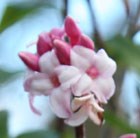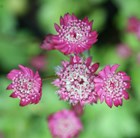New products at Crocus
by Sarah - April 25th, 2010.Filed under: Crocus, New Products.
New lines at Crocus

daphne £24.99
Position: full sun or partial shadeSoil: moderately fertile, well-drained, humus-rich soilRate of growth: slow-growing Flowering period: January and FebruaryHardiness: fully hardy (borderline)Clusters of small, sweetly scented, deep pink buds open in January and February and are followed by rounded, purple-black berries. This evergreen shrub thrives in a sunny, sheltered position. Try it in a mixed or winter border or next to a path where its fragrance can be appreciated. Strongly upright in habit, it looks wonderful underplanted with a carpet of magenta or white Cyclamen coum. All parts of the plant are toxic if ingested.Garden care: Keep pruning to a minimum since the plant is very susceptible to die-back. Where necessary after flowering, lightly trim back to remove misplaced branches and maintain a compact habit.

blueberry – early fruiting £9.99
Position: full sun or partial shadeSoil: prefers well-drained, acidic sandy loamRate of growth: averageOther features: light blue berries (June-July)Hardiness: fully hardyRenowned for producing some of the best flavoured blueberries, the attractive light blue fruits appear ealy in the season, are very large and have a tangy, sweet taste. The bush has upright growth to 1.8m at maturity, which makes picking very easy and the glossy green leaves turn attractive shades of yellow and orange in autumn. Ideally these plants should be planted in well-drained sandy loam with lots of additional organic matter.Garden care: Prepare the ground well before planting. Blueberries can also be grown in large pots and containers if ericaceous compost is used. Prune in winter, cutting out dead or damaged branches. In spring, feed with sulphate of ammonia, sulphate of potash and bonemeal and top-dress with ericaceous compost.

masterwort £6.49
Position: full sun or partial shadeSoil: fertile, moist, preferably humus-rich soilRate of growth: average to fastFlowering period: June to AugustHardiness: fully hardySmall, papery, plum-coloured, pincushion-like flowers surrounded by a ruff of wine-tinted bracts, are produced from June to August above deeply lobed, dark green leaves. Although it is an old cottage-garden favourite, this astrantia works equally well in contemporary-style plantings. Use it towards the front of a sunny, yet moist border. Astrantias do not like dry soil. The faded blooms are best cut back close to the ground to prolong flowering. Astrantias have been cultivated in Britainsince the 16th century and have numerous common names, such as melancholy gentleman, Hatties pincushion and the more well known masterwort.Garden care: Incorporate plenty of organic matter when planting and water well in dry weather especially newly established plants. Lift and divide large clumps in early spring and apply a generous 5-7 cm mulch of well-rotted manure or garden compost around the plant. Divided specimens may take some time to establish since they dont like having their roots disturbed.






